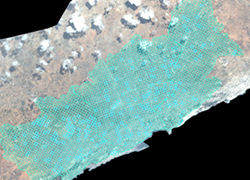Measuring Service Provision in Somalia
Researchers: Jesse Driscoll (GPS) and Nicholai Lidow (IGCC)
Location: Somalia

This project demonstrates the potential of using long-distance internet-enabled data collection methods as a supplement to follow-up surveys on the ground. This is particularly important in conflict and post-conflict settings, such as the study’s Mogadishu location, where in-person follow up can prove particularly problematic.
In Spring 2012, the study team conducted the first representative survey in Mogadishu (population of 1.03 million inhabitants) in 25 years, using emergent technologies to achieve an unbiased and representative sample of Mogadishu’s residents. A commercial satellite photograph of Mogadishu was used to create its sampling frame, with habitable structures coded pixel by pixel. The survey team was deployed using smartphone technology preloaded with maps to guide them from location to location. The survey solicited phone numbers from respondents at the end of the survey to establish a virtual sample.
Though the deterioration of the security environment in Mogadishu has frustrated attempts at a follow-up survey, the project has organized a Somali-language call center linking enumerators in San Diego to the same initially sampled respondents. In all, 252 phone numbers were collected in the 2012 survey. Three waves of callbacks have been implemented, successfully re-administering the survey to approximately half of the numbers in the initial sample.
This initial phase of the project was completed in 2013, demonstrating that cellphone numbers can be used to do remote follow up with respondents in Mogadishu, a conflict zone, many months after initial surveys. Of the 781 individuals initially selected for the household survey, 11 percent or 85 in total could be followed up with via cellphone, 16 months later. The resilience of this cellphone network has important implications for low-cost follow-up data collection methods, particularly in conflict and post-conflict areas.
The primary outcome variable that we employ in ongoing data analysis is a Mogadishu Welfare Index, which includes two measures of services and two measures of violence and insecurity. In order to assess the residual impact of Somali institution-building in the year prior to the survey, we constructed a Transitional Federal Government (TFG) Street Presence Index which measures what would indicate a visible presence of soldiers associated with the TFG.
There was some evidence that the formal structures of the Somali state enhanced welfare outcomes for Mogadishu citizens.
Driscoll, Jesse, and Nicolai Lidow. 2014. “Representative Surveys in Insecure Environments: A Case Study of Mogadishu, Somalia.” Journal of Survey Statistics and Methodology 2 (1):78–95.
Driscoll, Jesse, and Elaine Denny. “Acute Fear and Survey Behaviors: A Mogadishu Case Study.” Working paper, School of Global Policy and Strategy, University of California San Diego.
Driscoll, Jesse, and Elaine Denny. “Fear of Anarchy or Fear of a Predatory State? Using Survey Non-Response to Assess Somali State Legitimacy.” Working paper, School of Global Policy and Strategy, University of California San Diego.


